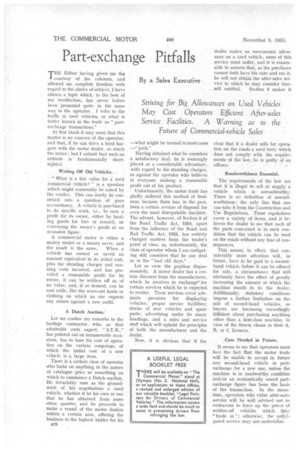Part-exchange Pitfalls
Page 150

If you've noticed an error in this article please click here to report it so we can fix it.
By a Sales Executive
THE Editor having given me the courtesy • of his columns, and allowed me complete freedom with regard to the choice of subject, I have chosen a topic which, to the best of my recollection, has never before been presented quite in the same way to the operator. I refer to the traffic in used vehicles, or what is better known in the trade as "partexchange transactions."
At first blush it may seem that this matter is no concern of the operator, and that, if he can drive a hard bargain with the motor dealer, so much the better ; but I submit that such an attitude is fundamentally shortsighted.
Writing Off Old Vehicles.
"What is a fair value for a' used commercial vehicle? " is a question _which might reasonably be asked by the vendee. This can surely be construed into a question of pure accountancy. A vehicle is purchased to do specific work, i.e., to earn a profit for its owner, either by hauling goods for hire or reward, or conveying the owner's goods at an economic figure.
A commercial motor is either a money maker or a money saver, and the result is the same. When a vehicle has earned or saved, an amount equivalent to its initial cost, plus the standing charges and running costs incurred, and has provided a reasonable profit for its owner, it can be written off as of no value, and, if so desired, can be Cast aside, like the worn-out boots or clothing on which no one expects any return against a new outfit.
A Dutch Auction.'
Let me confine my remarks to the haulage contractor, who, as that admirable costs expert, " S.T.R.," has pointed out on innumerable occasions, has to base his cost of operation on the various outgoings, of which the initial cost of a new vehicle is a large item.
There is a certain class of operator who looks on anything in the nature of catalogue price as something on which to commence a Dutch auction. He invariably uses as the groundwork of his negotiations a used vehicle, whether it be his own or one that he has obtained from some other quarter, and he proceeds to snake a round of the motor dealers within a certain area, offering the business to the highest bidder for his E28 —what might be termed in most cases —" junk."
Having obtained what he considers a satisfactory deal, he is seemingly placed at a considerable advantage, with regard to his standing charges, as against the operator who believes in everyone making a reasonable profit out of his product.
Unfortunately, the motor trade has gladly suffered this method of business, because there has, in the past, been a certain avenue of disposal for even the most disreputable machine. The advent, however, of Section 8 of the Road Traffic Act, 1934, apart from the influence of the Road and Rail Traffic Act, 1933, has entirely changed matters from the trader's point of view, as, unfortunately, the class of operator whom I am castigating still considers that he can deal as in the "bad old days."
Let us view the position dispassionately. A motor dealer has a certain discount from the manufacturer, which he receives in exchange' for certain services which he is expected to render. These services cover adequate premises for displaying vehicles ; proper service facilities; stocks of new vehicles and spare parts; advertising under its many headings, and a sales and service staff which will uphold the principles of both the manufacturer and the dealer.
Now, it is obvious that if the dealer makes an uneconomic allowance on a used vehicle, some of this service must suffer, and it is reasonable to assume that, as the purchaser cannot both have his cake and eat it. he will not obtain the after-sales service to which he may consider him self entitled. Section 8 makes it clear that if a dealer sells for operation on the roads a used lorry which does not comply with the requirements of the law, he is guilty of an offence.
Roadworthiness Essential.
The requirements of the law are that it is illegal to sell or supply a . vehicle which is unroadworthy. There is no definition of unreadworthiness ; the only line that one can take it from the Construction and Use Regulations. These regulations cover a variety of items, and it behoves the dealer to see that each of the parts concerned is in such condition that the vehicle can be used on the roads without any fear of consequences.
This means, in effect, that considerably more attention will, in future, have to be paid to a secondhand vehicle before it can be .offered for sale, a circumstance that will obviously have the effect of greatly increasing the amount at which the machine stands in to the dealer. Additionally, statutory conditions impose a further limitation on the sale of second-hand vehicles, as buyers are becoming exceedingly diffident about purchasing anything other than a first-class machine, in view of the fitness clause in their A, B, or C licences.
Care Needed in Future.
It seems to me that operators must face the fact That the motor trade will be unable to accept in future any second-hand vehicle in partexchange for a new One, unless the machine is in roadworthy, condition and/or an economically sound partexchange figure has been the basis of the transaction. In the meantime, operators who value after-sales service will be well advised not to endeavour to force up the prices of written-off. vehicles which they "trade in " ; otherwise, the anticipated service may not materialize.












































































































































































































































































































